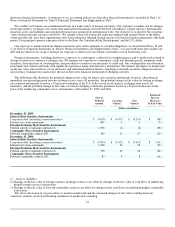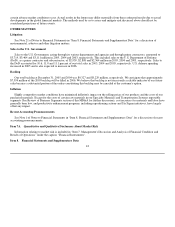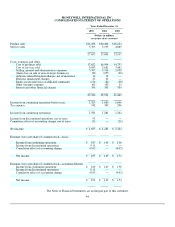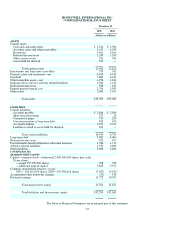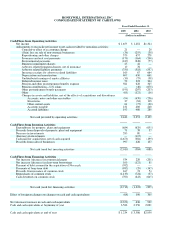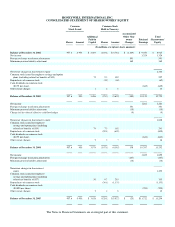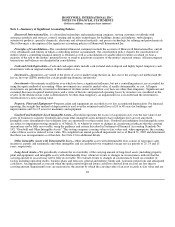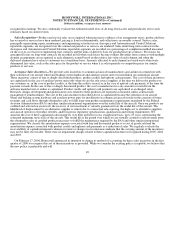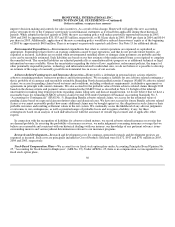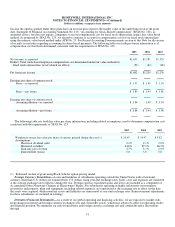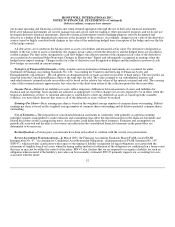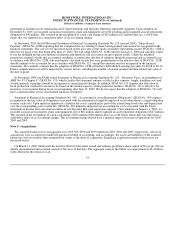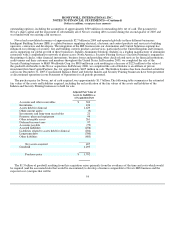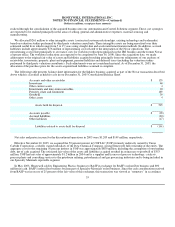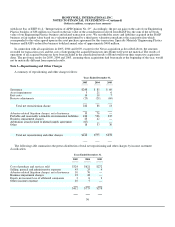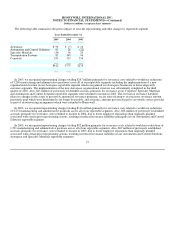Honeywell 2005 Annual Report Download - page 67
Download and view the complete annual report
Please find page 67 of the 2005 Honeywell annual report below. You can navigate through the pages in the report by either clicking on the pages listed below, or by using the keyword search tool below to find specific information within the annual report.
HONEYWELL INTERNATIONAL INC.
NOTES TO FINANCIAL STATEMENTS
(Dollars in millions, except per share amounts)
Note 1—Summary of Significant Accounting Policies
Honeywell International Inc. is a diversified technology and manufacturing company, serving customers worldwide with
aerospace products and services, control, sensing and security technologies for buildings, homes and industry, turbochargers,
automotive products, specialty chemicals, electronic and advanced materials, and process technology for refining and petrochemicals.
The following is a description of the significant accounting policies of Honeywell International Inc.
Principles of Consolidation—The consolidated financial statements include the accounts of Honeywell International Inc. and all
of its subsidiaries and entities in which a controlling interest is maintained. Our consolidation policy requires the consolidation of
entities where a controlling financial interest is obtained as well as consolidation of variable interest entities in which we bear a
majority of the risk to the entities' potential losses or stand to gain from a majority of the entities' expected returns. All intercompany
transactions and balances are eliminated in consolidation.
Cash and Cash Equivalents—Cash and cash equivalents include cash on hand and on deposit and highly liquid, temporary cash
investments with an original maturity of three months or less.
Inventories—Inventories are valued at the lower of cost or market using the first-in, first-out or the average cost method and the
last-in, first-out (LIFO) method for certain qualifying domestic inventories.
Investments—Investments in affiliates over which we have a significant influence, but not a controlling interest, are accounted for
using the equity method of accounting. Other investments are carried at market value, if readily determinable, or cost. All equity
investments are periodically reviewed to determine if declines in fair value below cost basis are other-than-temporary. Significant and
sustained decreases in quoted market prices and a series of historic and projected operating losses by investees are considered in the
review. If the decline in fair value is determined to be other-than-temporary, an impairment loss is recorded and the investment is
written down to a new carrying value.
Property, Plant and Equipment—Property, plant and equipment are recorded at cost less accumulated depreciation. For financial
reporting, the straight-line method of depreciation is used over the estimated useful lives of 10 to 40 years for buildings and
improvements and 3 to 15 years for machinery and equipment.
Goodwill and Indefinite-Lived Intangible Assets—Goodwill represents the excess of acquisition costs over the fair value of net
assets of businesses acquired. Goodwill and certain other intangible assets deemed to have indefinite lives are not amortized.
Intangible assets determined to have definite lives are amortized over their useful lives. Goodwill and indefinite lived intangible assets
are subject to impairment testing annually as of March 31, or whenever events or changes in circumstances indicate that the carrying
amount may not be fully recoverable, using the guidance and criteria described in Statement of Financial Accounting Standards No.
142, “Goodwill and Other Intangible Assets”. This testing compares carrying values to fair values and, when appropriate, the carrying
value of these assets is reduced to fair value. We completed our annual goodwill impairment test as of March 31, 2005 and determined
that there was no impairment as of that date. See Note 13 for additional details.
Other Intangible Assets with Determinable Lives—Other intangible assets with determinable lives consist of Aerospace sales
incentives, patents and trademarks and other intangibles and are amortized over weighted average service periods of 25, 19 and 15
years, respectively.
Long-Lived Assets—We periodically evaluate the recoverability of the carrying amount of long-lived assets (including property,
plant and equipment, and intangible assets with determinable lives) whenever events or changes in circumstances indicate that the
carrying amount of an asset may not be fully recoverable. We evaluate events or changes in circumstances based on a number of
factors including operating results, business plans and forecasts, general and industry trends and, economic projections and anticipated
cash flows. An impairment is assessed when the undiscounted expected future cash flows derived from an asset are less than its
carrying amount. Impairment losses are measured as the amount by which the carrying value of an asset exceeds its fair value and are
48


